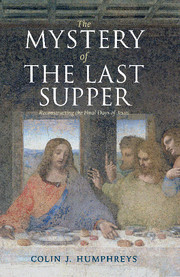Book contents
- Frontmatter
- Contents
- List of illustrations
- Foreword by I. Howard Marshall
- Acknowledgements
- 1 Four mysteries of the last week of Jesus
- 2 Dating the crucifixion – the first clues
- 3 The problem of the last supper
- 4 Can we reconstruct the Jewish calendar at the time of Christ?
- 5 The date of the crucifixion
- 6 The moon will be turned to blood
- 7 Did Jesus use the solar calendar of Qumran for his last supper Passover?
- 8 Does ancient Egypt hold a key to unlocking the problem of the last supper?
- 9 Discovering the lost calendar of ancient Israel
- 10 Was the lost ancient Jewish calendar used in Israel at the time of Jesus?
- 11 The date of the last supper: the hidden clues in the gospels
- 12 From the last supper to the crucifixion: a new analysis of the gospel accounts
- 13 A new reconstruction of the final days of Jesus
- Notes
- Bibliography
- Index of biblical and other ancient sources
- General index
2 - Dating the crucifixion – the first clues
Published online by Cambridge University Press: 03 May 2011
- Frontmatter
- Contents
- List of illustrations
- Foreword by I. Howard Marshall
- Acknowledgements
- 1 Four mysteries of the last week of Jesus
- 2 Dating the crucifixion – the first clues
- 3 The problem of the last supper
- 4 Can we reconstruct the Jewish calendar at the time of Christ?
- 5 The date of the crucifixion
- 6 The moon will be turned to blood
- 7 Did Jesus use the solar calendar of Qumran for his last supper Passover?
- 8 Does ancient Egypt hold a key to unlocking the problem of the last supper?
- 9 Discovering the lost calendar of ancient Israel
- 10 Was the lost ancient Jewish calendar used in Israel at the time of Jesus?
- 11 The date of the last supper: the hidden clues in the gospels
- 12 From the last supper to the crucifixion: a new analysis of the gospel accounts
- 13 A new reconstruction of the final days of Jesus
- Notes
- Bibliography
- Index of biblical and other ancient sources
- General index
Summary
Christ had been executed in Tiberius' reign by the Governor of Judea, Pontius Pilate.
(Tacitus, Annals 15.44)A small book my father gave to my younger daughter for her tenth birthday remains etched in my memory, and it unintentionally initiated my quest to discover the truth about the momentous last week of Jesus. The book was called Great Men of History. Why have I never forgotten this book? Because on the first page it listed every person described in the book and it gave their dates of birth and death, but against Jesus it had: ‘Born 4 bc? Died ad 30?’ Every other person listed on the front page – Julius Caesar, Alexander the Great, Christopher Columbus, and so on – was given a definite date of birth and death. Jesus was the only person whose dates of birth and of death were followed by question marks.
How strange, I thought. Jesus made a huge mark upon history, much greater than Julius Caesar, Alexander the Great or any of the other ‘historical greats’ listed. Yet the author of the book did not know the years in which Jesus was born and died. In fact historians and biblical scholars today are still uncertain about these dates. For example, the New International Version (NIV) Study Bible states regarding the life of Christ: ‘Exact dates, even year dates, are generally unknown.’
- Type
- Chapter
- Information
- The Mystery of the Last SupperReconstructing the Final Days of Jesus, pp. 14 - 25Publisher: Cambridge University PressPrint publication year: 2011



